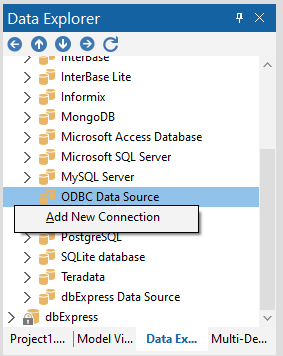Discover how a bimodal integration strategy can address the major data management challenges facing your organization today.
Get the Report →Viewing Elasticsearch Data in RAD Studio Data Explorer
How to view Elasticsearch data in RAD Studio Data Explorer using the CData ODBC Driver for Elasticsearch.
Embarcadero RAD Studio provides a development environment for Delphi and C++Builder applications. With the CData ODBC Driver for Elasticsearch, you gain access to live Elasticsearch data within RAD Studio, abstracting the data into tables, views, and stored procedures that can be used to both retrieve and update Elasticsearch data. This article will walk through connecting to Elasticsearch using the Data Explorer.
Configure a Connection to Elasticsearch
If you have not already, first specify connection properties in an ODBC DSN (data source name). This is the last step of the driver installation. You can use the Microsoft ODBC Data Source Administrator to create and configure ODBC DSNs.
Set the Server and Port connection properties to connect. To authenticate, set the User and Password properties, PKI (public key infrastructure) properties, or both. To use PKI, set the SSLClientCert, SSLClientCertType, SSLClientCertSubject, and SSLClientCertPassword properties.
The data provider uses X-Pack Security for TLS/SSL and authentication. To connect over TLS/SSL, prefix the Server value with 'https://'. Note: TLS/SSL and client authentication must be enabled on X-Pack to use PKI.
Once the data provider is connected, X-Pack will then perform user authentication and grant role permissions based on the realms you have configured.
Connecting to Elasticsearch Data Using Data Explorer
You can create a simple application for displaying Elasticsearch data by utilizing the CData FireDAC Components for Elasticsearch and a new VCL Forms Application:
- Open the Data Explorer in RAD Studio and expand FireDAC.
- Right-click the ODBC Data Source node in the Data Explorer.
- Click Add New Connection.
![Adding a New Connection. (Salesforce is shown.)]()
- Enter a name for the connection.
- In the FireDAC Connection Editor that appears, set the DataSource property to the name of the ODBC DSN for Elasticsearch.
![Setting the Connection Parameters. (Salesforce is shown.)]()
- Back in the Data Explorer, expand the tables for the connection.
Create a new VCL Forms application and drag a table (for example: Orders) onto the form.
![Placing the Table on the Form. (Salesforce is shown.)]()
- Select the OrdersTable object on the form and set the Active property to true.
Right-click on the object, bind visually, and link everything (*) to a new control (TStringGrid).
![Visually Binding the Table. (Salesforce is shown.)]()
Arrange the TStringGrid on the form and run the application to see the Orders data.
![The Table data on a Form. (Salesforce is shown.)]()
Related Articles
Below you can find other articles for using the CData ODBC Driver with RAD Studio, Delphi, and C++ Builder.











